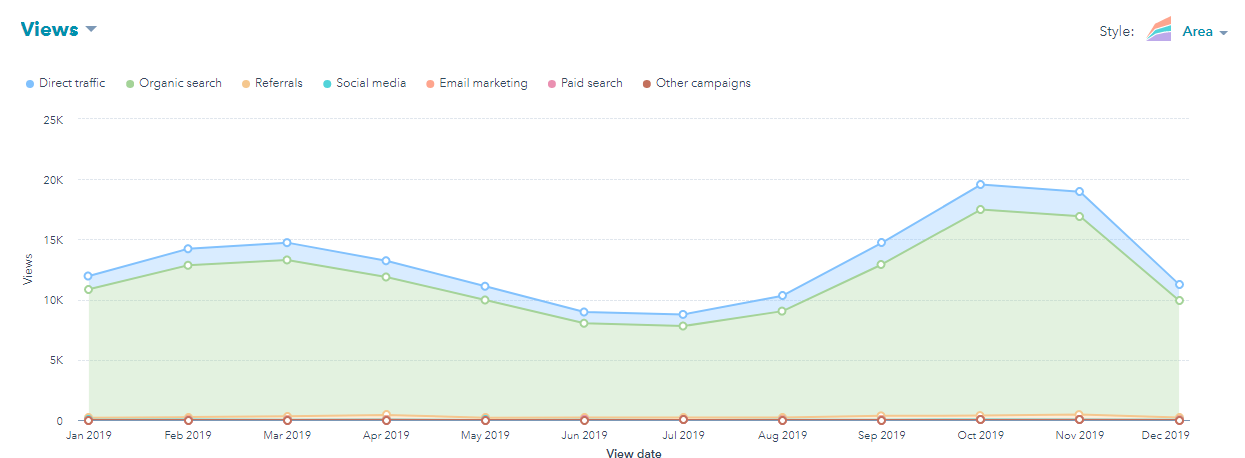Fear, uncertainty, doubt.
No, I’m not talking about the latest Stephen King horror novel. I’m talking about something all B2B marketers dread:
The content audit.
As a B2B marketer, you create a lot of content. Some of this might hit the target, but a lot of it is either outdated or underutilized.
The purpose of a content audit is to extract value from your entire content inventory.
This is a time-consuming and often confusing process, which is why so many marketers shy away from it.
But it doesn’t have to be that way. Content audits can be fast and even fun. In this guide, I’ll show you how to conduct a B2B content audit that is as effortless as it is effective.
What is a Content Audit?
Let’s start by digging into the basics – what exactly is a content audit and why should you do it?
A content audit is a process to take stock of your content inventory and analyze its impact quantitatively. Its purpose is twofold:
- Analyze content performance and identify relevant content pieces.
- Repurpose and redistribute existing content to targeted audiences.
For example, you might have a blog post that was written 5 years ago. This post draws a steady trickle of traffic, but the traffic graph looks something like this:

Upon analysis, you realize that this declining traffic graph is simply because the content is outdated. Updating the blog post and adding more recent data can make it more relevant, and thus, improve its performance.
How much time and effort a content audit takes will depend entirely on the size and age of your content inventory. Large businesses have content dating back decades that can still be valuable, while for a new startup, their inventory might not even include 100 pieces.
For example, when we first published this guide to Work Breakdown Structures (WBS) in 2018, it quickly ranked at the top of the SERPs. However, over time, the content became slightly outdated and traffic started dropping.
Once we updated it in the middle of 2019, traffic jumped up again as you can see below:

Regardless of the effort, a content audit can be a worthwhile exercise for three reasons:
- Improve SEO: Google has a known bias for new content – there is even a ‘Google Freshness’ algorithm update. Updating older content with fresher information can give it a boost in the SERPs, while also making it more relevant for current audiences.
- Extract value: Repurposing older content, repositioning it for a new audience, or redistributing it on a new channel – there are tons of ways to extract more value from existing content. A content audit can help you spot these underutilized content pieces and find new ways to use them.
- Find new ideas: A content audit tells you what content performed well in the past. This can inspire new ideas for current audiences. It can also help you pinpoint undervalued channels and underrepresented audiences.
If you’ve been creating content for more than a few years, consider an annual audit a necessary exercise. It will help you evaluate your performance, discover new opportunities, and most importantly, make sure that your content meets your quality standards.
Now the big question – how do you go about performing a content audit? I’ll share some answers below.
A Beginner’s Guide to Conducting a Content Audit
The first thing you should know is that there is no fixed path to running a content audit; everything depends on your current needs, skills, and resources.
A small startup looking to boost its SEO efforts will take a very different path than an enterprise B2B business looking to reboot its legacy content.
What matters more is understanding the core process of conducting a content audit and adapting it to your specific needs.
Let’s cover this process-driven approach in more detail below.
Start With a Content Inventory
A content inventory is a database of all your content along with key information such as:
- Content title
- URL (if online)
- Content-type (blog post, ebook, whitepaper, video, etc.)
- Content platform (blog, YouTube, LinkedIn, etc.)
- Word count
- Metadata (title, description, keywords)
- Word count
- Incoming/outgoing links
- Analytics data (traffic, bounce rate, average time on page)
- Marketing data (leads captured, subscribers, conversion rate, etc.)
- Images, videos, etc. on each content piece
You can add/remove from this list as per your needs and capabilities. You can also consider adding labels that are not apparent at a glance, such as overall focus (based on ‘AIDA’ – Attention, Interest, Desire, Action – principle), target persona, buyer’s journey stage, etc.
The purpose of a content inventory is to help you take stock of your content and analyze it quantitatively. Knowing how each piece performs is the first step in extracting value from your content efforts.
How you go about collecting all this data will depend on your current CMS and analytics/marketing tools. If you’re using something like HubSpot, you should have ready access to all key data.
Else, consider using a crawling tool like Screaming Frog to gather content data, then collate it with Google Analytics data.
There are also specialized tools like Content-Insight and BlazeContent to speed up the inventory creation process.
A final content inventory might look like this:

So far, we’ve only made a quantitative assessment of our content. But the heart of a content audit is qualitative analysis. For this, we need to map content to our audiences and figure out what to do with each content piece.
Analyze Your Content
What does your “ideal” content look like? Does it have a ton of shares? What segment of the buyer’s journey does it target? Does it rank well for a head keyword?
Figuring out the answers to these questions is the key to conducting a content audit. Your “ideal” content will help you assess the performance of your other content, but qualitatively and quantitatively.
Start by listing your key goals. What do you want to achieve with your content? More traffic? If yes, then what kind – search, social, or referral? Do you want more contacts? If yes, do you want just raw leads or MQLs (Marketing Qualified Leads)?
You can quantify your answers by scoring your content on these four counts:
- Traffic goals: Does the content attract enough readers? Are the readers from a preferred channel? Look at total pageviews, acquisition sources, etc.
- Engagement goals: Do people like to share the content? Do they spend a lot of time reading it? Look at bounce rate, average time on page, and the average number of shares.
- Lead goals: Does the content turn readers into leads? Do readers become blog subscribers? Are the leads relevant and high quality? Look at conversion rate, reader-to-subscriber rate, lead quality, etc.
- Branding goals: Does the content make our brand look good? Does it meet our quality standards? This is a subjective measure so you’ll have to evaluate each content piece on its own merits.
Pro Tip: “One metric you should definitely look at while auditing your pages is thin content. I define thin content to be any page with a word count of 300 words or less, that yields an average time on page of 30 seconds or less. If you have content that meets this criteria, it’s typically a sign of poor performance.” says Gaetano Dinardi Head of Demand Generation at Nextiva
Try to find content that scores a 10/10 on each of the above four counts. Use this to evaluate the rest of your content on a scale of 1 to 10.
For instance, an article that ranks #1 for its primary keyword and brings in 5,000 visitors/month gets a traffic score of 10/10. Another article that ranks #9 for its primary keyword and brings in 700 visitors/month would get a traffic score of 6/10.
Thus, you might have a table like this:

This might sound like a time consuming exercise, but it makes it so much easier to figure out what to fix in each content piece, as you’ll see below.
Create an Action Plan for Each Content
As you complete the above exercise, you’ll realize that virtually every content piece is deficient on some count. Some don’t bring in enough traffic, some can’t keep a reader’s attention, and some bring in low-quality, irrelevant leads.
Your next step, therefore, is to fix the deficiencies of each of your content pieces.
The content assessment exercise you completed above will be a huge help here. You can create an action plan based on the current quality, relevance, and resource requirements of each content piece.
Generally speaking, the lower a content piece scores on each of the four counts (traffic, engagement, lead, and branding), the more effort it will take to improve. Unless you have spare resources, it will be better to focus on “low hanging fruit”, i.e. moderately good content (say, a 5 or 6 out of 10).
Which aspects of the content you decide to change will depend on your short and long-term goals. If you’re trying to fix your branding, it will be better to bring all your 4-6/10 rated content to at least an 8/10 branding score level.
On the other hand, if your priority is to get more traffic, taking steps to improve the on-page SEO of each content piece should be your top priority.
Effectively, you will have four choices for each content piece:
- Discard: Content that is too outdated, irrelevant, or unsalvageable is best discarded. It will take too much effort to improve it to a point where it brings in a positive ROI. Your lowest scoring content will fall into this category.
- Update & Improve: This includes content that targets a desired channel, keyword, or audience; content that meets most but not all of your branding guidelines; content that is relevant but outdated.
- Merge: You’ll often have multiple content pieces targeting similar audiences or keywords. In such cases, it is best to merge all low-scoring content with a top-performing content that targets the same keyword/audience.
- Repurpose: Some of your content might have the right audience but the wrong format or platform. Alternatively, some of your content has enough potential to succeed on multiple platforms. Such content should be repurposed and redistributed as widely as possible.
You can use different colors to indicate your action plan for each content piece, like this:

Next Steps
This is not a comprehensive content audit by any means, but it should give you a start. There are plenty of other approaches to the auditing process, including evaluating content on the basis of type (ebook, whitepaper, blog post, etc.) and target audience.
For a beginner, however, simply finding and trimming away low-performing content will be good enough. A leaner, more focused content strategy where you regularly discard, merge, or repurpose low quality content will perform better in the long run.
As you improve your content inventory and content assessment skills, you can adopt a more subjective approach to the audit process. A skilled content marketer can usually spot “potential” in a piece of content based on their own reading of the market.
To start with, however, focus on developing a stronger content inventory and following the framework above in your content audit. Perform this exercise on a yearly basis at the very least for best results.
About the Author

Kate Lynch is a business and digital marketing blogger who spends her entire day writing quality blogs. She is a passionate reader and loves to share quality content prevalent on the web with her friends and followers, keeping a keen eye on the latest trends and news in those industries. Follow her on twitter @IamKateLynch for more updates.

